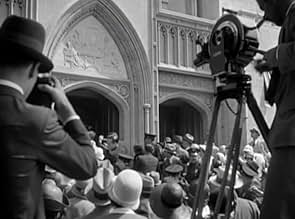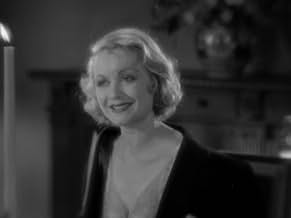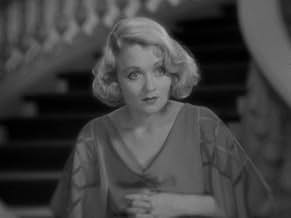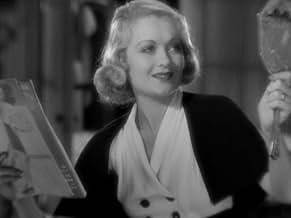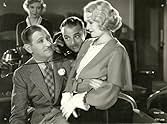VALUTAZIONE IMDb
7,0/10
2826
LA TUA VALUTAZIONE
La carriera di una cameriera sembra prendere il via quando incontra un'amabile e ubriacone regista di Hollywood.La carriera di una cameriera sembra prendere il via quando incontra un'amabile e ubriacone regista di Hollywood.La carriera di una cameriera sembra prendere il via quando incontra un'amabile e ubriacone regista di Hollywood.
- Regia
- Sceneggiatura
- Star
- Candidato a 1 Oscar
- 3 vittorie e 1 candidatura in totale
George Reed
- Undetermined Secondary Role
- (scene tagliate)
Alice Adair
- Undetermined Secondary Role
- (non citato nei titoli originali)
Eddie 'Rochester' Anderson
- James - Max's Butler
- (non citato nei titoli originali)
Sam Armstrong
- Undetermined Secondary Role
- (non citato nei titoli originali)
Zeena Baer
- Secretary to Julius Saxe
- (non citato nei titoli originali)
King Baggot
- Department Head
- (non citato nei titoli originali)
Gerald Barry
- John Reed - an Actor
- (non citato nei titoli originali)
Floyd Bell
- Undetermined Secondary Role
- (non citato nei titoli originali)
Veda Buckland
- Nana - Jackie's Nursemaid
- (non citato nei titoli originali)
Nicholas Caruso
- Chef at Brown Derby
- (non citato nei titoli originali)
Lita Chevret
- Actress Filming on Movie Set
- (non citato nei titoli originali)
Recensioni in evidenza
Another film that deserves a wider viewership and a DVD release, "What Price Hollywood?" looks at the toll Hollywood takes on the people who make it possible.
Adela Rogers St John wrote the Oscar-nominated story of a fading genius of a director, destroyed by drink, who launches one last discovery into the world. Lowell Sherman, himself both a director and an alcoholic, played the sad role that had been modeled, in part, on his own life. (Sherman's brother-in-law, John Barrymore, was also a model, as was the silent film director Marshall Neilan.) The divinely beautiful Constance Bennett plays the ambitious Brown Derby waitress who grabs her chance. Neil Hamilton, paired to great effect with Bennett that same year in "Two Against the World," plays the east-coast polo-playing millionaire who captures Bennett's heart without ever understanding her world.
George Cukor directed the film for RKO, and already the seeds of his directorial genius can be seen. Wonderful montages and double exposures chart Bennett's rise and fall as "America's Pal," and I've rarely seen anything as moving as the way Cukor presented Sherman's death scene, using quick shot editing, exaggerated sound effects and a slow motion shot. As startling as it looks today, one can only imagine the reaction it must have caused over 70 years earlier, before audiences had become accustomed to such techniques.
While the romantic leads are solid--Bennett, as always, especially so--and Gregory Ratoff is mesmerizing as the producer, hats must be doffed to Lowell Sherman for his Oscar-calibre performance. The slide from charming drunk to dissolute bum is presented warts and all, and a late scene in which the director examines his drink-ravaged face in the mirror is powerful indeed. It's hard to imagine what it must have been like for Sherman to play such a role and it was, in fact, one of the last roles he took for the screen, before concentrating on directing--then dying two years later of pneumonia.
When David O. Selznick made "A Star is Born" for United Artists five years later, four years after leaving RKO, the RKO lawyers prepared a point-by-point comparison of the stories, recommending a plagiarism suit--which was never filed. The later movie never credited Adela Rogers St John or any of the source material of "What Price Hollywood?" for its own screenplay, which was written by Dorothy Parker from, supposedly, an idea of Selznick's.
"What Price Hollywood?" is a great source for behind-the-scenes tidbits--Cukor fills the screen with images of on-set action (or inaction), with various crew waiting about as they watch the film-in-a-film action being filmed. This movie works as history and as innovation, but it also works on the most important level, as a well-told story.
Adela Rogers St John wrote the Oscar-nominated story of a fading genius of a director, destroyed by drink, who launches one last discovery into the world. Lowell Sherman, himself both a director and an alcoholic, played the sad role that had been modeled, in part, on his own life. (Sherman's brother-in-law, John Barrymore, was also a model, as was the silent film director Marshall Neilan.) The divinely beautiful Constance Bennett plays the ambitious Brown Derby waitress who grabs her chance. Neil Hamilton, paired to great effect with Bennett that same year in "Two Against the World," plays the east-coast polo-playing millionaire who captures Bennett's heart without ever understanding her world.
George Cukor directed the film for RKO, and already the seeds of his directorial genius can be seen. Wonderful montages and double exposures chart Bennett's rise and fall as "America's Pal," and I've rarely seen anything as moving as the way Cukor presented Sherman's death scene, using quick shot editing, exaggerated sound effects and a slow motion shot. As startling as it looks today, one can only imagine the reaction it must have caused over 70 years earlier, before audiences had become accustomed to such techniques.
While the romantic leads are solid--Bennett, as always, especially so--and Gregory Ratoff is mesmerizing as the producer, hats must be doffed to Lowell Sherman for his Oscar-calibre performance. The slide from charming drunk to dissolute bum is presented warts and all, and a late scene in which the director examines his drink-ravaged face in the mirror is powerful indeed. It's hard to imagine what it must have been like for Sherman to play such a role and it was, in fact, one of the last roles he took for the screen, before concentrating on directing--then dying two years later of pneumonia.
When David O. Selznick made "A Star is Born" for United Artists five years later, four years after leaving RKO, the RKO lawyers prepared a point-by-point comparison of the stories, recommending a plagiarism suit--which was never filed. The later movie never credited Adela Rogers St John or any of the source material of "What Price Hollywood?" for its own screenplay, which was written by Dorothy Parker from, supposedly, an idea of Selznick's.
"What Price Hollywood?" is a great source for behind-the-scenes tidbits--Cukor fills the screen with images of on-set action (or inaction), with various crew waiting about as they watch the film-in-a-film action being filmed. This movie works as history and as innovation, but it also works on the most important level, as a well-told story.
Pre-Code insider's look at Hollywood, a precursor to all those STAR IS BORN films.
Constance Bennett is a waitress at Hollywood's famed Brown Derby restaurant specifically for the chance of meeting the right contact to help her break into films. In walks Lowell Sherman, a tipsy but famous director. They take a shine to each other and he wakes up the next morning to find her asleep on his living room couch. He invites her to test for a small part in a film, but she's terrible.
She works all night on her little scene and finally gets it right. Of course she makes a hit and becomes a big star. She's never romantically involved with Sherman, who's more interested in the bottle. She has everything she ever wanted and marries a stuffy rich boy (Neil Hamilton) who never fits in.
Eventually Bennett loses the husband and also loses Sherman as his career slips away because of his drinking. The years go by. One night she gets a call to come get Sherman out of jail where he's been locked up for be drunk and for skipping out on a bar bill. She takes him home and cleans him up, but it's too late.
Hard-hitting story stunned a lot of viewers who wanted to believe that the lives of the Hollywood stars was a bed of roses. Bennett and Sherman are superb. Hamilton is fine as the rich husband. Also good are Gregory Ratoff as the producer and Louise Beavers as the devoted maid.
There were insider Hollywood stories before this. Marion Davies' comedy SHOW PEOPLE showed how fame can go to an actress' head. The following STAR IS BORN films borrowed heavily from this one but the heroines in these (Janet Gaynor, Judy Garland, Barbra Streisand, and the 2018 version) were all married to the tragic figure.
Perhaps a bigger studio than RKO could have secured the Oscar nominations Lowell Sherman and Constance Bennett deserved for this film.
Constance Bennett is a waitress at Hollywood's famed Brown Derby restaurant specifically for the chance of meeting the right contact to help her break into films. In walks Lowell Sherman, a tipsy but famous director. They take a shine to each other and he wakes up the next morning to find her asleep on his living room couch. He invites her to test for a small part in a film, but she's terrible.
She works all night on her little scene and finally gets it right. Of course she makes a hit and becomes a big star. She's never romantically involved with Sherman, who's more interested in the bottle. She has everything she ever wanted and marries a stuffy rich boy (Neil Hamilton) who never fits in.
Eventually Bennett loses the husband and also loses Sherman as his career slips away because of his drinking. The years go by. One night she gets a call to come get Sherman out of jail where he's been locked up for be drunk and for skipping out on a bar bill. She takes him home and cleans him up, but it's too late.
Hard-hitting story stunned a lot of viewers who wanted to believe that the lives of the Hollywood stars was a bed of roses. Bennett and Sherman are superb. Hamilton is fine as the rich husband. Also good are Gregory Ratoff as the producer and Louise Beavers as the devoted maid.
There were insider Hollywood stories before this. Marion Davies' comedy SHOW PEOPLE showed how fame can go to an actress' head. The following STAR IS BORN films borrowed heavily from this one but the heroines in these (Janet Gaynor, Judy Garland, Barbra Streisand, and the 2018 version) were all married to the tragic figure.
Perhaps a bigger studio than RKO could have secured the Oscar nominations Lowell Sherman and Constance Bennett deserved for this film.
One of George Cukor's earliest successes before his glory years at MGM was this classic What Price Hollywood. Done at RKO it's the story of three star crossed people and that's literal for one of them.
Constance Bennett plays Mary Evans who is discovered by drunken director Lowell Sherman while working as a waitress at the famous Brown Derby in Hollywood. In 1932 that was the place to be if one wanted to be discovered because all the Hollywood celebrities dined there at one time or another. Including those like Sherman who liked their cuisine strictly liquid and at that time illegal.
You might think that playing a movie star was no stretch for Connie Bennett. But she and her sisters Joan and Barbara were of a distinguished theatrical family with father Richard Bennett in Hollywood himself at that time. She was as far removed from Mary Evans in real life as you can get, still Bennett got deep inside the part.
Sherman might have modeled his character on any number of distinguished Hollywood lushes. He probably took bits from all of them, but his director is uniquely his own, at once self centered, talented, vain and frail.
The third part of this triangle is Neil Hamilton, polo playing scion of a prominent society family who is introduced to Bennett when he smacks her with a polo ball. It was definitely love at first sight, but love between them takes a rocky road.
Hollywood has never been easy on itself. The movie industry figures that the scandals they've had are all too public so honesty is probably the best policy. In the sound era What Price Hollywood is one of the first of a long line of critical examination of the movie industry that also includes The Big Knife, The Bad And The Beautiful, Callaway Went Thataway and Two Weeks In Another Town. And of course we can't forget A Star Is Born in its original and remakes.
What Price Hollywood got an Oscar nomination for Best Original Screenplay. As its done before the Code, it holds up well today as a mark of distinguished and mature film making.
Constance Bennett plays Mary Evans who is discovered by drunken director Lowell Sherman while working as a waitress at the famous Brown Derby in Hollywood. In 1932 that was the place to be if one wanted to be discovered because all the Hollywood celebrities dined there at one time or another. Including those like Sherman who liked their cuisine strictly liquid and at that time illegal.
You might think that playing a movie star was no stretch for Connie Bennett. But she and her sisters Joan and Barbara were of a distinguished theatrical family with father Richard Bennett in Hollywood himself at that time. She was as far removed from Mary Evans in real life as you can get, still Bennett got deep inside the part.
Sherman might have modeled his character on any number of distinguished Hollywood lushes. He probably took bits from all of them, but his director is uniquely his own, at once self centered, talented, vain and frail.
The third part of this triangle is Neil Hamilton, polo playing scion of a prominent society family who is introduced to Bennett when he smacks her with a polo ball. It was definitely love at first sight, but love between them takes a rocky road.
Hollywood has never been easy on itself. The movie industry figures that the scandals they've had are all too public so honesty is probably the best policy. In the sound era What Price Hollywood is one of the first of a long line of critical examination of the movie industry that also includes The Big Knife, The Bad And The Beautiful, Callaway Went Thataway and Two Weeks In Another Town. And of course we can't forget A Star Is Born in its original and remakes.
What Price Hollywood got an Oscar nomination for Best Original Screenplay. As its done before the Code, it holds up well today as a mark of distinguished and mature film making.
"What Price Hollywood?" is one of my favorite films of the 1930s. With loads of drama, glamour to spare, and some romance too, this movie is one of the best behind-the-scenes looks at the old Hollywood studio system that was ever made. Constance Bennett, looking her radiant best, plays the lead role with finesse. Lowell Sherman also turns in a powerful performance as a washed-up director. This movie was the basis for "A Star is Born." All in all, one great film.
It's fun to compare "What Price Hollywood," made in 1932, to the more familiar 1937 version of "A Star is Born" (as well as its two later remakes). An important historic event intervened between the two: the Hays Code became rigidly enforced in 1934. The 1932 version is much spicier. Mary, the unknown knockout in in the 1932 version, is a saucy waitress at the legendary Brown Derby restaurant trying to catch the eye of a movie big shot. She's pretty sophisticated and, you believe, would happily do whatever is required to land an acting job. She readily allows herself to be picked up and taken to a premiere by a famous (but fading) director, which launches her great career. In the 1937 version, Esther, the ingenue, is straight off the farm and comes to Hollywood without a clue about the movie biz. She's a goody-two-shoes who would be shocked about what it usually takes to break into the biz. She catches the eye of a famous (but fading and highly alcoholic) actor when she waitresses at a party.
There is one major plot difference: in the 1932 version, Mary marries a rich polo playing socialite who divorces her (while she's pregnant) because he is fed up with movie people. This is highly realistic--movie stars had terrible marital problems. In the 1937 version, Esther marries the actor who was her mentor and is sucked into his hopeless downward spiral. Divorce is a perfectly acceptable solution to marital problems in 1932 but, under the constraints of the Code, was out of the question in 1937.
Both films are well worth seeing. They're loaded with insights about Hollywood and filmmaking (both the creative and the business end), the rapacious movie press, and the fans--an insatiable monster that devours the object of its affection. The declining fortunes of the director (in "What Price Hollywood") and the actor (in "A Star is Born") are quite fascinating. But of the two--the 1932 version is a lot more fun.
There is one major plot difference: in the 1932 version, Mary marries a rich polo playing socialite who divorces her (while she's pregnant) because he is fed up with movie people. This is highly realistic--movie stars had terrible marital problems. In the 1937 version, Esther marries the actor who was her mentor and is sucked into his hopeless downward spiral. Divorce is a perfectly acceptable solution to marital problems in 1932 but, under the constraints of the Code, was out of the question in 1937.
Both films are well worth seeing. They're loaded with insights about Hollywood and filmmaking (both the creative and the business end), the rapacious movie press, and the fans--an insatiable monster that devours the object of its affection. The declining fortunes of the director (in "What Price Hollywood") and the actor (in "A Star is Born") are quite fascinating. But of the two--the 1932 version is a lot more fun.
Lo sapevi?
- QuizThis film bears such a striking resemblance to È nata una stella (1937) that it is often considered "the original version" of that often remade classic. In fact, David O. Selznick, who produced both this film and Star is Born, was threatened with a lawsuit by this film's writers, claiming plagiarism.
- BlooperWhen the screen shows a newspaper gossip column, part of an item relating a joke about a Jewish boy and a bird can be seen. Several months later, another gossip column shows the identical item.
- Curiosità sui creditiThere is a "by" credit to Gene Fowler and Rowland Brown after the title shows, but there is also a "screenplay by" credit to Jane Murfin and Ben Markson, without leaving any clear explanation or context as to what "by" actually means. But the reality was that Fowler and Brown wrote the real screenplay, with Murfin and Markson providing the continuity.
- ConnessioniFeatured in David O. Selznick: 'Your New Producer' (1935)
- Colonne sonoreThree Little Words
(1930) (uncredited)
Music by Harry Ruby
Part of a medley played during the opening credits
I più visti
Accedi per valutare e creare un elenco di titoli salvati per ottenere consigli personalizzati
- How long is What Price Hollywood??Powered by Alexa
Dettagli
- Data di uscita
- Paese di origine
- Lingue
- Celebre anche come
- What Price Hollywood?
- Luoghi delle riprese
- Azienda produttrice
- Vedi altri crediti dell’azienda su IMDbPro
Botteghino
- Budget
- 411.676 USD (previsto)
- Tempo di esecuzione1 ora 28 minuti
- Colore
- Proporzioni
- 1.37 : 1
Contribuisci a questa pagina
Suggerisci una modifica o aggiungi i contenuti mancanti

Divario superiore
By what name was A che prezzo Hollywood? (1932) officially released in India in English?
Rispondi
